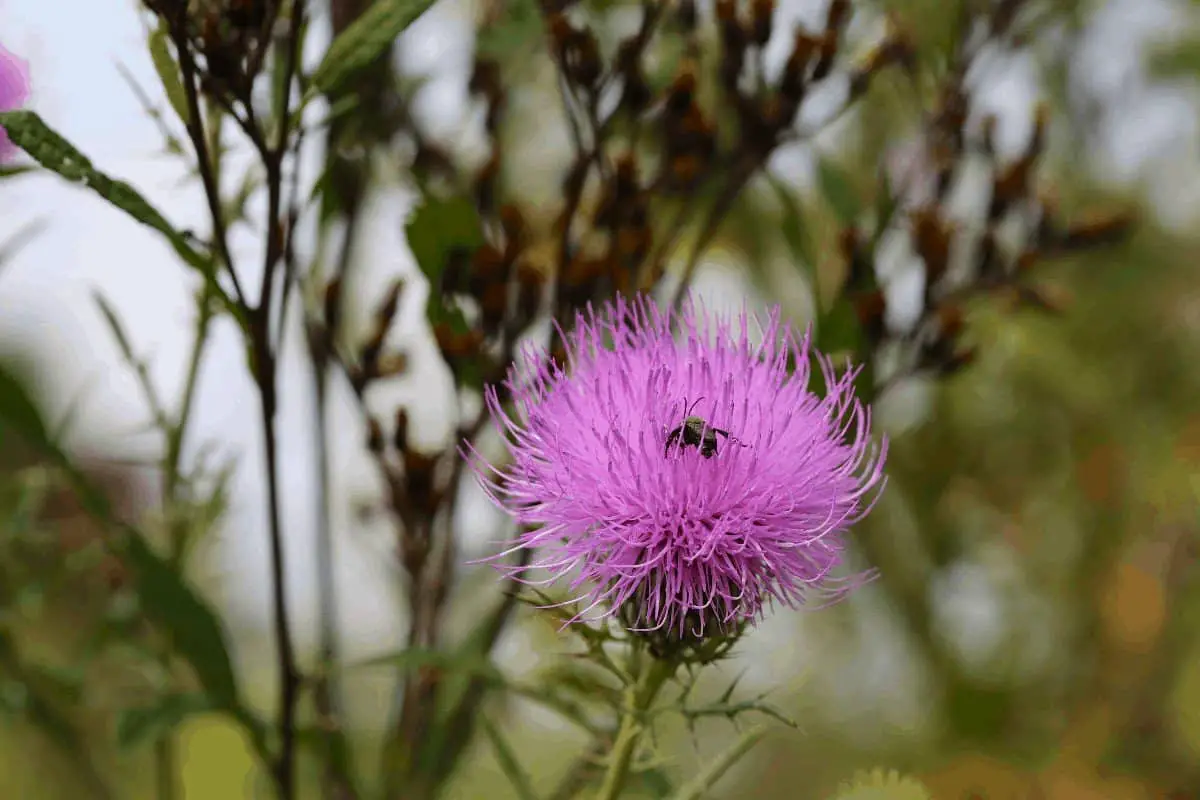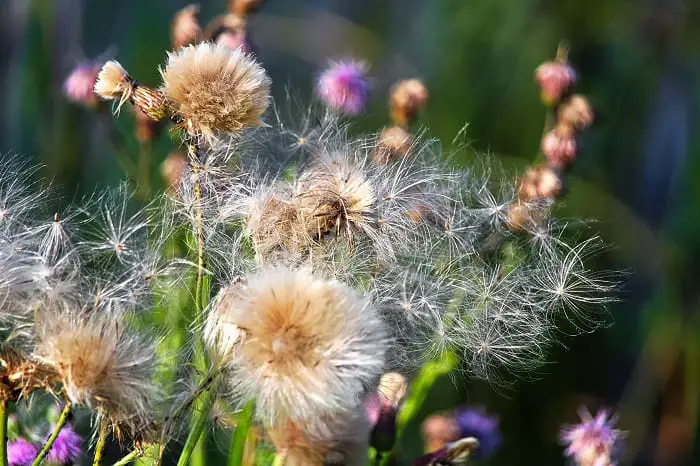Last Updated on December 29, 2021 by
Canadian thistle can be a gardeners’ worst nightmare. It’s an annoying, ugly weed that can be hard to get rid of. Every gardener wants to know: How to get rid of Canadian thistle?
Whether you’re an avid gardener or enjoy planting in your free time, thistle plants are not something you want in your garden. Thistle plants spread aggressively, taking valuable space away from your precious plants. Fortunately, there are ways to get rid of this annoying weed so you can have your dream garden.
How to Get Rid of Canadian Thistle?
Canada thistle can be tricky to get rid of. It grows at a rapid rate and can spread quickly. Within one season, a patch can expand up to ten feet in width.
Though it may be tempting to rip thistle right out of the ground, that is not a good idea. Even the smallest bit of thistle left behind from a root can grow back. Large patches of thistle are often made up of one plant, with hundreds, possibly thousands, of stems emerging.
Unfortunately, there is not a one-step process to get rid of Canada thistle. It generally takes multiple treatments over multiple seasons. However, with time, patience and the proper treatment, you can eliminate your yard of thistle plants.
What is Canadian Thistle?
Canada thistle, also referred to as Canadian thistle, creeping thistle or field thistle, originated in Europe and was brought over to North America in the 1600s. It has now become an invasive species, with its aggressive growing and ability to spread at a rapid rate. It often outcompetes other plants for new areas to grow.
It is well known for its irregular lobbed, lance-shaped leaves. When the thistle blooms, small purple rosettes emerge. It can grow as high as five feet tall and is most recognizable in July when the seed heads develop white fluffy tops.
This plant has a negative impact on the environment, as it takes land away from native plants, especially ones that promote grasslands. Thistles have also caused problems for farmers, as they invade precious farmlands and destroy crops.
Thistle can grow just about anywhere. They often thrive in open, low fertile soil areas, especially when there is a lot of rain. Their ability to grow in a wide variety of habitats makes them difficult to get rid of.
When is the Best Time to Get Rid of It?
To fully eliminate Canada thistle, you must injure and deplete its root system. This is likely a process that will take repeated steps over multiple seasons. Unlike other plants, eliminating thistle is not done in one day.
Fall is the best time to get rid of thistle. During the fall, the thistle is preparing for winter by recharging its root system. This allows herbicides to travel directly to the root system, maximizing injury to the plant.
Late spring is the second most important time to get rid of the thistle. When the plant is getting ready to bud, it requires a lot of energy. This means it will be at a seasonal low of stored energy, making it more susceptible to herbicides.
Herbicide
One of the best ways to get rid of thistle is by using herbicides. Glyphosate 4 or 2 4-D Amine are ideal herbicides for fighting thistle plants, as they are systematic and will kill the plant down to the root.
It is best to use herbicide in fall and then follow up in spring, as these are the times Canada thistle is most vulnerable. When using herbicides, you want to be careful to get it on only the thistle, as it will kill other plants. Warmer days often work best for using herbicide on thistle plants.
Whenever you are using herbicide, it is always important to make sure you have gloves, glasses and a mask. This will help protect you from coming in contact with any herbicide.
When using herbicides, you want to be very careful. Most herbicides contain poisonous chemicals, so it is important to spray it away from areas where children and pets go.
Salt and Vinegar
If you are looking for an all-natural way to get rid of Canada thistle, salt and vinegar is a great choice. Vinegar is a natural weed repellent and one of the most efficient ways to get rid of thistle. It is also much more environmentally and family-friendly than herbicides.
To get rid of thistle with salt and vinegar, fill up a spray bottle with vinegar and do not dilute it. Cut the stem of the thistle and spray the vinegar directly on it, while avoiding getting the soil. Then sprinkle a pinch of salt at the base of the plant, as it will dehydrate the thistle.
Reapply as needed until the thistle is fully eliminated. This is a simple, effective and safe way to get rid of Canada thistle.
Mowing
Though mowing may not fully eliminate thistle plants, it can help prevent it from growing and spreading. It is best to mow thistle while it is in the early bloom state. Since the thistle is low on stored energy in spring, the roots will suffer greater damage.
Mowing throughout the summer will help keep seed production down and will stunt the growth of thistles. Mowing thistle on a regular basis will help control it and make it easier to get rid of. Make sure to clean your mower off so no seeds spread after each mow.
An Annoying Invasive Weed
Canada thistle can be difficult to get rid of, however, with the right process, you can successfully eliminate it from your yard and garden. Since it is an invasive species, not native to North America, it is always best to get rid of it when possible.
Though it will take time and patience, following these steps can help eliminate and manage thistle plants:
- Herbicide
- Salt and Vinegar
- Mowing
Please comment if you enjoyed this article or have any questions or remarks regarding eliminating Canada thistle!
FAQs
How do I get rid of Canadian thistle naturally?
Canadian thistle is a weed that can cause problems in your garden. It can be found in many places, and it usually grows at a faster rate than other plants. Canadian thistle is also very difficult to remove when it's grown in dense clusters, which makes it hard to see the roots as you try to pull them out.
There are some different ways that you can try to get rid of Canadian thistle naturally, but you will need patience and persistence for this process because it requires a lot of time and effort. Canadian thistle grows very quickly and its seeds remain viable for up two years in the soil.
You can dig it out by hand, use a rotary hoe, or you can spray herbicide on the plants and wait for them to die.
If there is no effective way to get rid of the Canadian thistle in your garden, you have to wait for it to die and then remove it manually.
How do I permanently get rid of thistles?
Thistles are a perennial problem for gardeners. They are a nuisance as they compete for nutrients with your plants and can invade from the sides of your garden beds.
There are two ways of permanently getting rid of thistles - one is physical removal, which means pulling up the plants by their roots or chopping them into pieces; and the other is chemical removal which involves using either herbicides or insecticides.
Why is Canada thistle a problem?
Canada thistle is a perennial plant that is found in many parts of North America. It has the characteristic of spreading rapidly and provides a dense thicket of vegetation.
Canada thistle is a problem because it can block roads, impede drainage systems and cause serious ecological damage to land. It often grows in high traffic areas like parks, golf courses and shorelines which means it poses a significant risk to people.
Canada thistle has also been known to grow in green spaces, where it can quickly become problematic due to its ability to choke out other plants.
Is Canada thistle poisonous?
Canada thistle is a plant native to the United States, Canada and Mexico. It is often found in fields, pastureland and disturbed areas.
While it does not cause any serious harm to humans, Canada thistle can sometimes be a threat for farm animals. The plant contains some toxicity that can potentially irritate the stomach of animals like cattle, horses or sheep.
How do I identify my Canada thistle?
Canada thistle is a perennial weed with yellow flowers. It is considered a noxious weed because it crowds out native plants and is considered to be a weed by many farmers, gardeners, and landscapers across Canada.
It can be identified by its flat leaves that are up to 10 centimeters wide. The leaves do not have teeth at the edges and grow from an underground stem that can be up to 1 meter long. The plant also has small white flowers that bloom in mid-to late summer on short stalks near the leaves of the plant.
Canada thistle has a strong, pungent odor when crushed or pulled apart.
amzn_assoc_placement = “adunit0”;
amzn_assoc_tracking_id = “gardeningdreams-20”;
amzn_assoc_ad_mode = “manual”;
amzn_assoc_ad_type = “smart”;
amzn_assoc_marketplace = “amazon”;
amzn_assoc_region = “US”;
amzn_assoc_linkid = “d6b7604dafd810a6a1477a6eafbbb801”;
amzn_assoc_design = “in_content”;
amzn_assoc_asins = “B005G6J266,B07GSGFBRN”;
Tony Manhart is a passionate gardener who has been tending to gardens for over 20 years. He takes pride in creating beautiful outdoor spaces with plants, trees, and shrubs that can thrive in any environment. He loves to share his knowledge with others and has taught classes on gardening basics and advanced techniques. He is committed to sustainability, using natural and organic methods to create and maintain gardens. He also works with local organizations to create green spaces for communities. When he’s not gardening, Tony enjoys hiking, reading, and spending time with his family.




